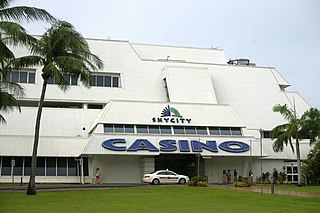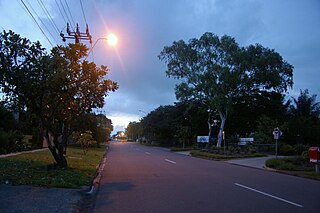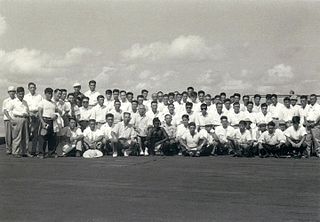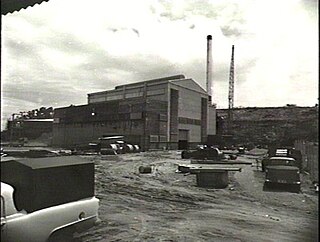
Mindil Beach Casino & Resort is a casino in Darwin, Northern Territory, Australia, owned and operated by Delaware North. It is the only casino in Darwin.

Pine Creek is a small town in the Katherine region of the Northern Territory, Australia and is situated just off the Stuart Highway; it is 90kms north of Katherine. As at the 2021 Census there were 318 residents of Pine Creek, which is the fourth largest town between Darwin and Alice Springs.

Larrakeyah is an inner suburb of Darwin, the capital city of Australia's Northern Territory. It is the traditional country and waterways of the Larrakia people. It was one of the first parts of the city to be developed, and borders the Darwin Central Business District.

The Victoria Hotel, or The Vic as it is commonly known, is a heritage listed pub located in Darwin, Northern Territory, Australia. Built in 1890, it is an important historical building but is currently closed.

Lily Ah Toy was an Australian pioneer and businesswoman famous in the Northern Territory.

Ormond Harold Edward George Snell, best known as Harold Snell, was a soldier, miner, primary producer, carpenter, builder and businessman in the Northern Territory of Australia. He built many historic buildings in Darwin.
Beni Carr Glyn Burnett (1889–1955) was the Commonwealth principal architect for the Northern Territory of Australia. He designed many well-known heritage buildings in both Darwin and Alice Springs. He is known for designing innovative, climate-appropriate buildings.

Hotel Darwin was a hotel located on the Esplanade in central Darwin in the Northern Territory of Australia. It was commonly known as the "Grand Old Duchess". Despite surviving the Bombing of Darwin and Cyclone Tracy, the hotel was demolished in 1999. A bar at the rear of the original site formerly known as the Hot & Cold Bar now functions under the name Hotel Darwin.

The Star Theatre was the first purpose-built cinema in Darwin in the Northern Territory of Australia. Destroyed during Cyclone Tracy, it was the centre of Darwin's social life between the 1930s and 1960s.

Kahlin Compound was an institution for part-Aboriginal people in Darwin in the Northern Territory of Australia between 1913 and 1939. After 1924, "half-caste" children were separated from their parents and other adults and moved to an institution at Myilly Point.

Tuxworth Fullwood House is a historic building in Tennant Creek in the Northern Territory of Australia. It was known as the No. 55 Australian Camp Hospital during World War II becoming the Tennant Creek Hospital Outpatients Department after the war. It was the first brick building constructed in the town and is one of the last remaining military structures in the Barkly region.

The Fujita salvage operation was a two-year marine salvage operation of World War II shipwrecks in Darwin Harbour in the Northern Territory of Australia from 1959 to 1961.

Barbara James was an author, historian, journalist, political adviser and activist based in Darwin in the Northern Territory of Australia. James is best known for documenting the contribution of women to the development of the Northern Territory in books and articles, most significantly, the award-winning No Man’s Land: Women in the Northern Territory. She was also a press secretary and adviser to Bob Collins, Leader of the Territory Opposition and Senator for the Northern Territory and later Clare Martin, Chief Minister of the Northern Territory.
Olga Havnen is an Aboriginal leader, advocate and activist in the Northern Territory of Australia. She is currently the chief executive officer of the Danila Dilba Health Service in Darwin, an Aboriginal Community Controlled Health Service.

Brown's Mart, which now houses the Home of Territory Performing Arts, Brown's Mart Arts and the Brown's Mart Theatre, is a historic building located in Darwin in the Northern Territory of Australia.
National Trust of the Northern Territory is a membership-based community organisation to "promote the natural, Indigenous and cultural heritage" of the Northern Territory. It was founded in 1976 by Adele Purvis, of Woodgreen Station.
Larrakeyah Barracks Sergeants Mess is a heritage-listed barracks at Herring Road, Larrakeyah, Northern Territory, Australia. It was added to the Australian Commonwealth Heritage List on 22 June 2004.
Larrakeyah Barracks Headquarters Building is a heritage-listed office building at Fullarton Place, Larrakeyah, Northern Territory, Australia. It was added to the Australian Commonwealth Heritage List on 22 June 2004.

Stokes Hill Power Station was an oil-fired thermal power station in Darwin, Northern Territory, Australia. During its operating life, it was the largest power station in the Northern Territory, although it was considered unreliable and highly inefficient. Stokes Hill's high operating costs required government to heavily subsidise power bills for Darwin residents, who frequently experienced supply disruptions.

The Darwin Hospital was a former hospital that was located at Myilly Point in Larrakeyah, an inner suburb of Darwin, Northern Territory in Australia. It was the second public hospital to be built in the city, replacing a facility that had originally opened in 1874 nearby on Packard Street, Larrakeyah. The hospital had a short but eventful history, being extensively damaged by air-raids during World War II and by Cyclone Tracy in 1974. For most of its operating life, the hospital maintained segregated wards for Aboriginal patients, a policy that did not extend to those of mixed race or Asian descent. It was replaced by Royal Darwin Hospital in the early 1980s.
















